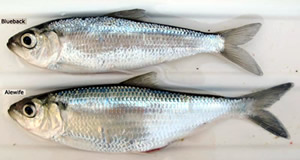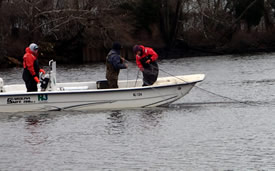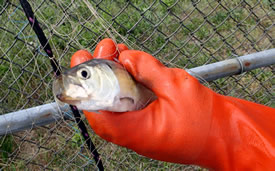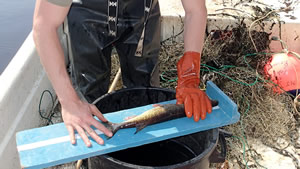by Rachel Reinhard, Hourly Fisheries Technician
NOTE: This article is one in the series, A Day In the Life Of a Marine Fisheries Hourly.
The introduction of dams in waterways and construction projects around rivers are just some of the major obstacles facing the species. These dams inhibit the species' ability to migrate to spawning sites. Overfishing, bycatch and the return of striped bass populations have also contributed to the decline in numbers. After assessing the scope of problems facing river herring, the Atlantic States Marine Fisheries Commission (ASMFC) put a ban on the harvest of any river herring in 2013. One year before the ban, a project was introduced by the Division of Fish and Wildlife's Marine Fisheries Administration to research herring species and to track their population sizes.
A typical day of gill-netting starts at 6:30 a.m. at the Nacote Creek Research Station in Atlantic County. Once the crew arrives at the station, the van is packed with personal gear, such as boots, gloves, rain bibs and rain jackets. The boat is then checked to ensure that all the necessary equipment is aboard. This includes two gill nets, baskets to hold the nets, buoys, anchors, pliers and picks, pH and dissolved oxygen meters, measuring boards, a live-well to hold fish, dip nets, data sheets and buckets. When everyone is ready to go, we trailer the boat to either the Maurice or Great Egg Harbor River. At the river, the team puts on their bibs and boots and we launch the boat into the water. Once on the water, we head north to our first sampling location and deploy the first gill net. The first net we set is 174' in length with a 3" mesh. First, the small buoy is hooked to the float line of the net and one of the anchors is attached to the lead line. Both the anchor and buoy are thrown over the bow of the boat and two team members work together to feed the net out of its basket. Once we reach the end of the net, the large buoy is attached to the float line and another anchor is clipped to the lead line. To straighten the net out in the water, the float line and lead line are held by team members and the boat is put into reverse. Once the gill net is straightened out, each team member lets go of their line; the net is now set. Next, I calibrate the dissolved oxygen meter and collect readings for salinity, dissolved oxygen, water temperature, pH and air temperature which are all recorded onto datasheets. These same steps are repeated for the second, southerly location. The only difference is that the net for the second location is a bit smaller at 141' with a 3" mesh size. Nets are typically allowed to soak for 90 minutes. After the soak time is completed, we retrieve the nets and assess our catch. Two team members simultaneously pull the net in over the bow by the lead and the float line.
Once the entire net is pulled in and placed back in its basket, we can begin measuring the fish. Counts and measurements are taken for all fish, including both target species and bycatch. Target species include any river herring species (alewife, blueback herring, shad) and striped bass. When target species are found, fork and total tail measurements of length are recorded. Only fork measurements and counts are taken for bycatch species. Some common bycatch species that we often find in the nets include white perch, white catfish, and chain pickerel.
To learn more about river herring and these surveys please see the following:
River Herring Status: Research Holds the Key (eRegs, 2018 Marine Digest)
|
||||||||||||||
|
||
|
|
||
|
||
| |
||





